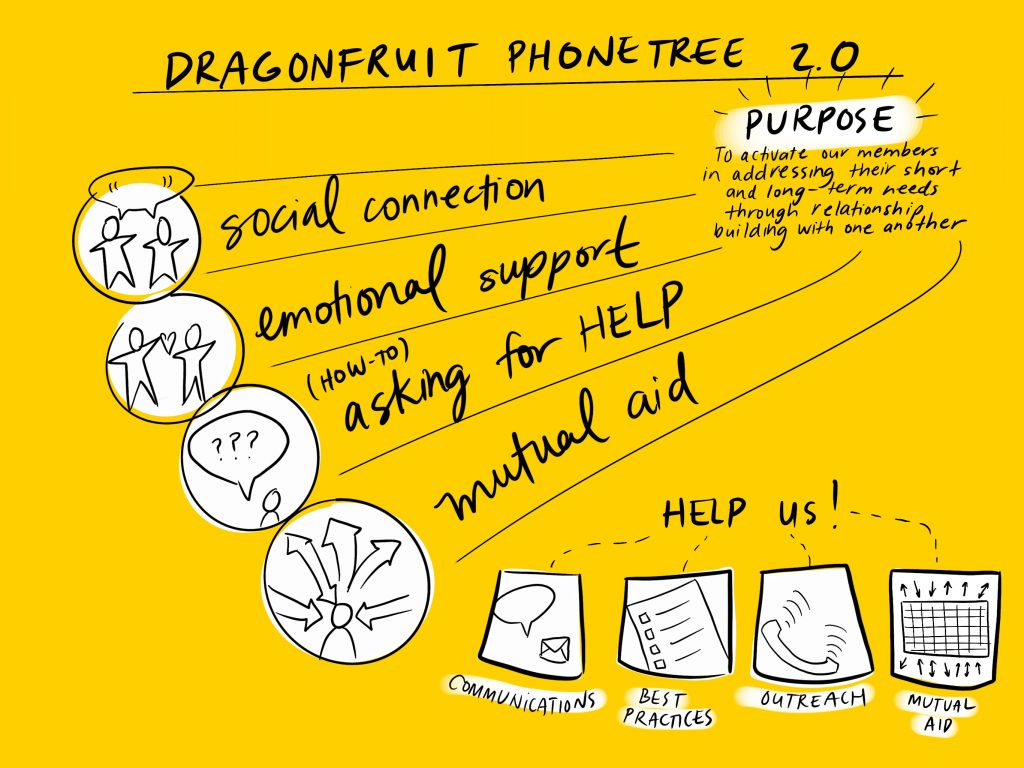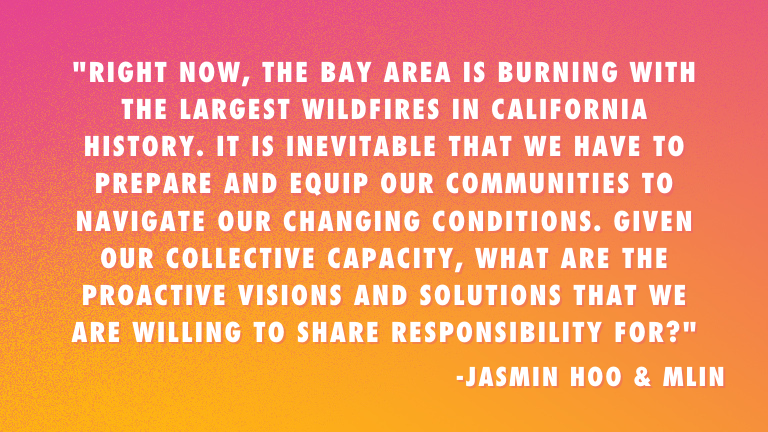Hello are you there? Reflections from our Dragon Fruit Phone Tree
It all started with the Dragon Fruit Project (DFP) reunion, scheduled to happen on March 21, 2020. Since last December, a volunteer team had been planning for an in-person event to celebrate all those who had contributed to our intergenerational Dragon Fruit oral history project. However, as the date came closer and as COVID-19 spread in the Bay Area, the team decided to indefinitely postpone the event, and to prioritize the safety and health of participants who were planning to attend. Even though we were physically unable to see each other, we decided to offer a Phone Tree as a resource for community members to check in with one another. As the COVID-19 crisis escalated, California officially put into place Shelter-In-Place orders that would drastically change our community’s needs and ways of organizing.
During this time, a rad, multi-generational group of organizers emerged to figure out how to build up the DFP Phone Tree to support APIENC community members in staying connected and grounded. Over the next 3 months, our organizing team met weekly to coordinate and match 38 people into small pods, prompting participants to touch base, get to know each other, and discuss their needs. Behind the scenes, the team approached the Phone Tree project with a lot of energy, passion, and experience working with each other in different capacities. However, defining emergent work during a global pandemic proved difficult. Our team struggled with finding shared purpose, aligning expectations, and maintaining the momentum needed to coordinate so many people. We also grappled with how to claim ownership, share responsibility, and make decisions for a project of this scale and level of urgency. In June, the organizers made a proactive decision to pause Phone Tree efforts and take the time to regroup.
Now, Jasmin and MLin are taking some time to share our learnings and reflections from working on the Phone Tree. We asked each other some questions and got deep!

Why did you get involved with the Phone Tree?
Jasmin: I was excited to help people connect with each other, especially as Shelter In Place (SIP) became most people’s reality. Many trans and queer API people already feel very isolated due to systemic and internalized oppression. With the SIP orders, everyone, especially elders, youth, trans people, and immunocompromised people were becoming even more isolated and needing more social connection. As someone with physical health issues that sometimes prevent me from going out and being with community, I really appreciate when someone calls me to check in on how I am doing. Our Dragon Fruit Project and Network is all about building connections across generations and practicing skills of interdependence; a Phone Tree seemed like a simple, low-tech, yet effective way to keep our APIENC people connected.
MLin: I got involved because the Phone Tree was a timely opportunity to initiate a concrete support network. Circumstances were converging, needs were heightened, and we knew that relationships are critical to staying connected with each other. At the beginning of 2020, when we were planning for the DFP reunion event, I had looked forward to finally reconvening past DFP volunteers. When preparing for the event, I engaged in multiple conversations about our mutual learnings and challenges from being involved with APIENC. Our willingness to get vulnerable and talk about how DFP has been a part of our personal growth and current perspectives regarding QTAPI community organizing was fulfilling and healing for me. When the DFP reunion was inevitably postponed due to COVID-19, I was motivated to continue intentionally reconnecting and reflecting with people.
What were your hopes and fears going into this process? How did these influence your involvement?
Jasmin: I hoped that this Phone Tree would help people feel more connected and cared for during the COVID pandemic. I also wanted it to be a site of practice in building relationships and interdependence, so that individuals and groups could build their own networks of care. I was worried about sustainability, and one of my biggest fears was that you, MLin, as a former Community Organizer at APIENC, would end up taking on too much undue responsibility. Uneven responsibility has been a pattern before, where APIENC staff have to hold a lot more responsibility than volunteer members, and as a result, staff can burn out. I didn’t want that to happen with the Phone Tree. Another fear I had was acting from a place of control, rather than community. In my current role as a staff member, one pattern that I’ve recognized in myself is that I struggle with control issues. I fear that if something fails it will be all my fault, and I’m slowly but surely working on this personal issue. As this rapid response project was evolving, I hoped I could let go of control and listen to and take the lead of the community more.
MLin: Rather than proposing resources for community members to build their own Phone Tree, I felt strongly that we should actually try building a Phone Tree itself. The Bay Area is an unique landscape where there are already existing mutual aid resources and networks – and I still think that we have a valuable role to play in supporting even more people to create pods and genuine relationships. When attending a transformative justice seminar facilitated by Mia Mingus, I resonated with Mia’s question: “How can I meet my immediate needs to get closer to my long term goals and the world I want to live in?” Building community is literally the practice of building relationships.
Quite honestly, I was afraid that if the Phone Tree “failed” and we couldn’t maintain participants’ connections, I would be held responsible. My reflection now is that I am still unlearning a lot of my default organizing behaviors. Funny enough, it relates to what Jasmin mentions around control, trust, and letting go. My hopes and fears didn’t mesh well together, so I’m still curious what a Phone Tree could look like if a year’s worth of energy, commitment, and time was put into this work. If I trust more in the formation and the people who are doing the work, what kind of impact could we make?
What was our process for organizing the Phone Tree? How did we do outreach and support people to build relationships?
We created a sign-up form that we began sharing with our broader APIENC community (not just DFP volunteers) to fill out if they were interested in connecting with other community members during Shelter-in-Place. As participants signed up, they were assigned into pods, based on available time and noted preferences. Organizers communicated with these pods via email and text, to provide guidelines on how the pods could connect. Pods were encouraged to start from a place of curiosity as they got to know each other. Suggested question prompts included: “How are you feeling today physically and emotionally?”, “What is helping you feel grounded?”, “What is helping you stay connected these days?”
After this initial round of matching, the organizing team reached out to the pods through texts, phone calls, and a feedback survey to assess participants’ needs and expectations. Here are some key learnings that we found:
- Communication requires commitment: As many of our interactions moved online, everyone was receiving an overload of digital communication. Although email allowed us to reach a larger group of people at once, this form of outreach was less effective in getting direct and timely responses. Both organizers and participants had to put in additional effort to follow up via texts or phone calls. For context, we asked Phone Tree participants to self-coordinate their conversations. Roughly 50% of pods were able to connect at least once. The other 50% of pods struggled to find a time to connect due to difficulty with scheduling or not getting a response from their pod members.
- Relationship-building requires shared intention, trust, and consistency: The majority of Phone Tree participants noted that they were seeking social and emotional support, as opposed to needing mutual aid assistance. For those who did get to connect, they gave input that they appreciated the experience to get to know new people, see how their pod members were navigating Shelter-in-Place, and feel a sense of community despite physical distance. However, participants also observed that it was hard to talk about needs and ask for help from their fellow pod members due to limited trust and familiarity with each other. As participants were unsure about the Phone Tree’s duration and long-term purpose, they asked for Phone Tree organizers to provide more guidance and infrastructure on how to connect with their pods.

What felt challenging to us individually, and us collectively?
I also think we were scared of burning ourselves out or burning out other volunteers, and these fears put us into a scarcity mindset.
Jasmin: MLin and I actually had a moment of tension that came up very early on in the Phone Tree process. My controlling tendencies came up and I ended up rushing us to make a decision around transferring ownership of the Phone Tree, without first checking in with the planning group. MLin and I were able to resolve this conflict together, but it foreshadowed challenges that our planning group had throughout the process. I think this particular group of organizers are all people who take on a lot of responsibility for our community, which is why we all wanted to help with the Phone Tree. I also think we were scared of burning ourselves out or burning out other volunteers, and these fears put us into a scarcity mindset. For example, we tried to find out what our community needed (through surveys and 1-1 calls), but as we opened up to the possibility of hearing people’s needs, there was a moment where organizers worried “What if we can’t meet everyone’s needs?” We worked through that particular fear by naming it, and understanding that we, as the organizing group, could set parameters and boundaries for what we could offer. Despite the weight of responsibility we felt when making big decisions that would impact our community, we continued forward, though it was a slow process that eventually left us at low capacity. Looking back, we probably could have practiced asking for help more, while also looking to historical and current examples of community rapid response networks to guide us, so we wouldn’t feel (ironically) so isolated in the process.
MLin: My main source of tension was not wanting to initiate all things that we did. In the process of “organizing organizers,” I resisted holding the main responsibility of bottom-lining the Phone Tree. I felt passionate and confident about organizing a group to start working on the Phone Tree, but I also didn’t want the organizing group to become dependent on my proactiveness. As the project was coming into formation, I wanted to make sure people’s ideas were heard and validated. Simultaneously, I felt specific pressure to consolidate everyone’s ideas into something comprehensive and actionable. This pressure came from instances when people asked questions such as “What is the Phone Tree?” or “Can the Phone Tree incorporate ____?” It was hard for me to respond to all these questions because my instinctive answer was, “Well, it’s up to all of us to define and realize.”
Learning from my past experiences, I wanted to approach Phone Tree organizing as something that was generative, flexible, and from a place of collective agency. In the 90 minutes we had to meet each week, a lot of this time was put towards figuring out our shared purpose: “WHAT” were we organizing and “HOW” would it happen? This process reminded me of my past experiences with organizing APIENC projects, where the labor of “stewarding the work” defaulted on select individuals. Though I had extra time to do tasks like define next steps, do preliminary research, and facilitate group-based decision-making, I knew that if I continued holding the bulk of these tasks, the work itself wouldn’t be sustainable.
Final reflections from this moment and moving forward?

Right now as we write this blog post, the Bay Area is burning with the largest wildfires in California history, putting those most vulnerable at even more risk. It is inevitable that we have to prepare and equip our communities to navigate our changing conditions. As we envision our futures, it is essential to document and honor our challenges, learnings, and reflections. How have we been aligning our short-term strategies with our long-term priorities? Given our collective capacity, what are the proactive visions and solutions that we are willing to share responsibility for?
As the uprisings from the Black community around the murders of Breonna Taylor, George Floyd, and Tony McDade materialized in June, many APIENC community members pivoted towards supporting the Movement for Black Lives. During the summer, APIENC also shifted from organizing the Phone Tree to organizing a mutual aid project to meet people’s short-term material needs. At the time, this is what APIENC was ready to offer. During this era of intersecting crises, driven by white supremacy, climate destruction, and economic exploitation, our lessons learned from organizing the Phone Tree are critical and relevant.
The original intention for the Phone Tree was to provide a localized tool to initiate and sustain intergenerational relationships with our Dragon Fruit Project community. It was an intuitive move to center our relationships, for the sake of our present and future resilience. Today, how can we activate our Phone Tree learnings to mobilize around our current and impending crises? We know that we have been changed by this world and that we have also changed it. If change is constant, what are we changing for the world that we want to live in?
***
MLin is an avid volunteer and South Bay Area local, who loves being organized by organizers. MLin was a former staff member at APIENC from 2015-2018 and is now pursuing the art of getting buff (via weightlifting), going on creative adventures with friends, and keeping their skin moisturized.
Jasmin is a mixed race queer organizer raised near Boston, who has lived in the Bay Area since 2005 working with schools and community organizations. She is currently on staff at APIENC and loves co-creating our intergenerational work with the Dragon Fruit Project and Dragon Fruit Network.

